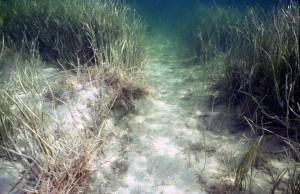As part of the ongoing Natural Resource Damage Assessment (NRDA) that has followed the Deepwater BP oil spill, federal and state partners have reached an agreement with BP to begin a new effort to restore submerged aquatic vegetation that was damaged by response vessels and activities.
Emergency restoration projects like this one are intended to reduce or prevent ongoing or potential injuries to natural resources resulting from the spill and related response activities. NOAA will lead the Gulf seagrass restoration effort, which also will include state co-trustee agencies and the National Park Service. BP will pay to implement these projects.
During the spill, the threat of oil reaching shorelines was real. Many response vessels across the Gulf were mobilized to place boom along shorelines and across smaller bays and estuaries in Louisiana, Mississippi, Alabama and Florida. The placement of these booms over sensitive, shallow seagrass habitats resulted in damage to these important nursery habitats.
"The scars created by these boats damaged seagrass and removed sediment, which can kill plants and prevent them from growing back," said Sean Meehan, NOAA oceanographer. "Storm waves and currents can exacerbate the damage if we don't intervene."
The project, like all NRDA projects, began with science: specifically, using photos taken from airplanes and specialized computer software to get a better idea of where the SAV damage might be. Then, researchers from across the country, working for state and federal agencies, used GIS mapping techniques to determine where damage was likely. This allowed us to be more efficient by targeting our survey locations to areas that we knew were likely to be affected.
Now teams are going out into the field to survey those areas identified by scientists to get a better idea of how much damage the seagrass beds have sustained.
Restoration could include:
- replacement of sediment to bring elevation levels back to their original height to allow plants to reestablish,
- planting seagrasses, and
- placement of bird roosting stakes to help fertilize the damaged areas.
The rehabilitated sites will be monitored for at least five years to document the effectiveness of the restoration or to allow for mid-course correction to the restoration design.
Seagrass beds provide habitat for wildlife, help absorb the impact of storm surges and waves during hurricanes, and help stabilize sediments to prevent erosion. This is especially important in the Gulf, where wetlands are eroding at an increasingly rapid rate. These projects are intended to provide restoration of areas at risk of further injury and are not proposed as a means to restore all impacts of the BP oil spill.
Partner agencies continue to assess the damage and restore the Gulf Coast.


